To learn more about Eastern Lowland Gorillas, we need to look at the two main species of gorillas and their sub-species. There are two main species of gorillas – The western and eastern gorilla. The western gorilla is divided into two subspecies – Western lowland gorillas and Cross River gorillas. The Eastern gorilla is also divided into two subspecies – The Mountain gorilla and the Eastern lowland gorilla, also known as the Grauer’s gorilla.
The Grauer’s gorilla (Gorilla beringei graueri) or Eastern Lowland Gorilla is only found in the eastern part of the Democratic Republic of Congo. They live in tropical rain-forests in mountainous and lowland areas of Eastern Democratic Republic of Congo. The largest population live in Kahuzi Biega National Park. Another large population lives in Maiko National Park but they can also be found in small numbers in adjacent forests and reserves (Itombwe Massig, Usala forest and Tayna Gorilla reserve).
Eastern Lowland Gorilla Weight, Size and Height
Eastern lowland gorillas are the largest of the gorilla subspecies and hence the largest primates still roaming earth. They look similar to mountain gorillas but with differences that we shall discuss later. An adult male weighs about 210 kilograms while females reach an average weight of about 100 kilograms. Eastern lowland gorilla feed on stems, fruits, bark, leaves and occasionally on insects (termites and ants). Like all gorilla sub-species, the Grauer’s gorilla is a very sociable and peaceful primate.
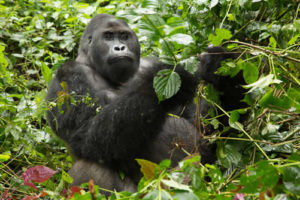 They live in groups that can contain up to 30 individuals. Each group composed of a dominant male, females and younger ones. Silverback gorillas protects all members of the group from danger. Gorilla breeding and reproduction is initiated by the female once they reach estrous. Younger males will leave the group on reaching maturity and form a family of their own after attracting females from neighboring groups. Females also leave the group on maturity to join other families or a lone silverback. Gorilla breeding and reproduction is initiated by the female once they reach estrous. A female will give birth after about 9 months. The infant relies on breast milk for 3 years after which it is weaned. Eastern lowland gorillas mature at the age of 8 (females) and 12 (males).
They live in groups that can contain up to 30 individuals. Each group composed of a dominant male, females and younger ones. Silverback gorillas protects all members of the group from danger. Gorilla breeding and reproduction is initiated by the female once they reach estrous. Younger males will leave the group on reaching maturity and form a family of their own after attracting females from neighboring groups. Females also leave the group on maturity to join other families or a lone silverback. Gorilla breeding and reproduction is initiated by the female once they reach estrous. A female will give birth after about 9 months. The infant relies on breast milk for 3 years after which it is weaned. Eastern lowland gorillas mature at the age of 8 (females) and 12 (males).
Difference Between Eastern lowland gorillas (Grauer’s Gorilla) and Mountain gorillas
Most people find it difficult to differentiate between Mountain gorillas and the Grauer’s gorilla. Although they all belong to the eastern gorilla species, they have clear differences in both behavior and appearance. Mountain gorillas generally live in higher altitude areas compared to Eastern lowland 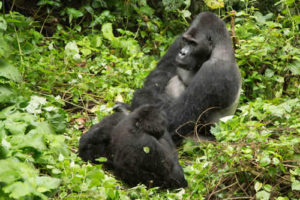 gorillas. They can be found in the Volcanoes National Park of Rwanda, Bwindi Impenetrable National Park of Uganda, Mgahinga Gorilla Park in Uganda and Virunga National Park in the Democratic Republic of Congo. As we already mentioned earlier, Grauer’s gorillas are only found in the Democratic Republic of Congo. Physically mountain gorillas are smaller in size compared to the Eastern lowland gorillas. They have shorter arms and jaws. The Eastern lowland gorilla may be larger but have smaller noses and teeth when compared to mountain gorillas. Mountain gorillas have thicker and longer coats compared to Grauer’s gorillas. The average weight of an adult male mountain gorilla is 195 kilograms while a male eastern lowland gorilla weighs about 210 kilograms on average.
gorillas. They can be found in the Volcanoes National Park of Rwanda, Bwindi Impenetrable National Park of Uganda, Mgahinga Gorilla Park in Uganda and Virunga National Park in the Democratic Republic of Congo. As we already mentioned earlier, Grauer’s gorillas are only found in the Democratic Republic of Congo. Physically mountain gorillas are smaller in size compared to the Eastern lowland gorillas. They have shorter arms and jaws. The Eastern lowland gorilla may be larger but have smaller noses and teeth when compared to mountain gorillas. Mountain gorillas have thicker and longer coats compared to Grauer’s gorillas. The average weight of an adult male mountain gorilla is 195 kilograms while a male eastern lowland gorilla weighs about 210 kilograms on average.
Both gorilla species are led by a dominant silverback but it is more common to have other silverbacks in mountain gorilla groups. Eastern lowland gorilla groups often have only one silverback with mating 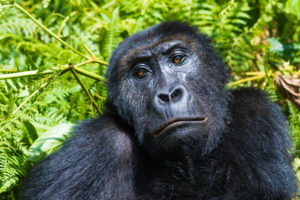 rights to all females in the group. It has also been observed that mountain gorillas isolate themselves from the group when angry/irritated. The silverback will emit a strong odor from his armpit to show that he is stressed and needs time alone. Eastern lowland gorillas have not been observed demonstrating this behavior. As we will learn in shortly, the Grauer’s gorilla is the most threatened of all the four gorilla sub-species. The overall population of Mountain gorillas is lower but increasing at a faster rate because relative stability in Rwanda and Uganda.
rights to all females in the group. It has also been observed that mountain gorillas isolate themselves from the group when angry/irritated. The silverback will emit a strong odor from his armpit to show that he is stressed and needs time alone. Eastern lowland gorillas have not been observed demonstrating this behavior. As we will learn in shortly, the Grauer’s gorilla is the most threatened of all the four gorilla sub-species. The overall population of Mountain gorillas is lower but increasing at a faster rate because relative stability in Rwanda and Uganda.
Grauer’s Gorilla – Threats in their natural habitat
Grauer’s gorilla (Gorilla beringei graueri) are listed as critically endangered by the International Union for Conservation of Nature (IUCN). This means that the primates are at a great risk of extinction if more work is not done to protect them. As the largest apes in the world, the Eastern lowland gorilla needs to be protected even more. There are very few individuals living in captivity. If they became extinct in their wild habitats, they would be lost forever.
In the early 1990’s, the number of Eastern lowland gorillas was estimated to be about 17,000 individuals. However, it is estimated that about 3500 eastern lowland gorillas are left in the wild. This is quiet low when you consider that there are over 250,000 western lowland gorillas. The greatest threat to the Grauer’s gorilla is destruction of habitat (agriculture, mining and logging), civil unrest, poaching and inbreeding.
Poachers target Eastern lowland gorillas because of the high demand of their bush meat. Gorilla meat is still considered a special delicacy among communities, miners, loggers and people displaced by the civil war in the Eastern DR Congo. It is estimated that each year, about 250 eastern lowland gorillas are killed to supply meat to eager consumers.
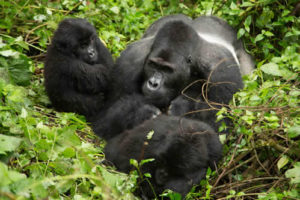 Apart from poaching for bush meat, the other threat to the gorillas is civil unrest. Violence in the areas close to the gorilla habits makes research and monitoring difficult. It is also more difficult to implement policies against poaching in areas with little to no government control. Rebels see forests as a safe haven as do refugees. In order to survive, they are forced to hunt wild animals including gorillas. Illegal logging is carried out by individuals for charcoal and companies with no permits or rights to do so. These companies often work with militia groups for protection and stopping their activities is next to impossible.
Apart from poaching for bush meat, the other threat to the gorillas is civil unrest. Violence in the areas close to the gorilla habits makes research and monitoring difficult. It is also more difficult to implement policies against poaching in areas with little to no government control. Rebels see forests as a safe haven as do refugees. In order to survive, they are forced to hunt wild animals including gorillas. Illegal logging is carried out by individuals for charcoal and companies with no permits or rights to do so. These companies often work with militia groups for protection and stopping their activities is next to impossible.
Last but not least, researchers have found evidence of inbreeding in some of the eastern lowland gorilla groups. This lack of variation/diversity is thought to be due to low levels of individual migration. The Researchers go on to suggest that breeding programs should be initiated in captivity with the purpose reintroducing the primates to groups with different genes.
Eastern Lowland Gorilla Conservation
In order to deal with the challenges facing Eastern lowland gorillas, wildlife conservation organizations like the Wildlife Conservation Society (WCS), International Gorilla Conservation Program, WWF, Fauna & Flora International (FFI), Dian Fossey Fund and German Development Agency have helped re-arm guards because of inadequate government funding to the national parks and reserves. The guards undergo training and help with enforcing lows that have been enacted with the purpose of protecting the primates. FFI has been working in Regomuki and Regolu – two community reserves that are home to Eastern Lowland gorillas. They help train and equip community rangers. By building local capacity, the two reserves can conduct patrols and record the presence of gorilla families and other threatened species like the Congo peafowl, Chimpanzees and Okapi. During these patrols, rangers also destroy snares that could be dangerous to the gorillas.
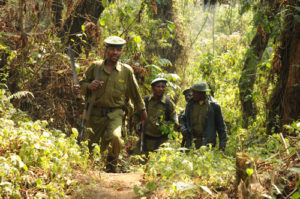 The Dian Fossey Fund begun working with Grauer’s gorillas in 2001. In 2012, they helped establish the Nkuba Conservation area which has about 200 gorillas. The organization worked closely with the local communities by employing former hunters and improving their lives so that they are less inclined to hunt down the primates. Community sensitization are very important in educating people living close to the parks and reserves about the importance of protecting the primates for posterity. Through its African Great Apes Programme, the WWF has been involved in several measures to protect the Graeur’s gorilla. They are also funding and equipping anti-poaching patrols. Moreover, they have also assisted in establishing a management structure/plan for the Itombwe Massif which is next to Kahuzi Biega National Park.
The Dian Fossey Fund begun working with Grauer’s gorillas in 2001. In 2012, they helped establish the Nkuba Conservation area which has about 200 gorillas. The organization worked closely with the local communities by employing former hunters and improving their lives so that they are less inclined to hunt down the primates. Community sensitization are very important in educating people living close to the parks and reserves about the importance of protecting the primates for posterity. Through its African Great Apes Programme, the WWF has been involved in several measures to protect the Graeur’s gorilla. They are also funding and equipping anti-poaching patrols. Moreover, they have also assisted in establishing a management structure/plan for the Itombwe Massif which is next to Kahuzi Biega National Park.
Despite the great efforts of the above gorilla conservation Agencies, it is very important that peace returns to the Eastern part of the Democratic Republic of Congo so that the government can get even more involved in protecting the different Grauer’s gorilla habitats. Urgent action by the government of Congo and wildlife Agencies is required to stop the illegal logging, poaching or destruction of gorilla habitat before it gets too late.
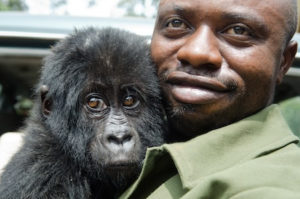 How can you help? By avoiding buying forest products that are not FSC certified. This will help stop illegal logging and trade. You can also support the work of the above organizations by visited their websites individually and making a donation. You could also visit or donate to the Grace Center for orphaned Grauer’s Gorillas. Another indirect way of contributing to the conservation of Lowland gorillas is to go and see them in the wild. Eastern lowland gorilla trekking in Kahuzi Biega has gained popularity and helped attract extra funding needed to run the park. Last but not least is helping spread the word after observing them in the wild.
How can you help? By avoiding buying forest products that are not FSC certified. This will help stop illegal logging and trade. You can also support the work of the above organizations by visited their websites individually and making a donation. You could also visit or donate to the Grace Center for orphaned Grauer’s Gorillas. Another indirect way of contributing to the conservation of Lowland gorillas is to go and see them in the wild. Eastern lowland gorilla trekking in Kahuzi Biega has gained popularity and helped attract extra funding needed to run the park. Last but not least is helping spread the word after observing them in the wild.
More Facts about Grauer’s gorillas
Although Grauer’s gorillas are still referred to as eastern lowland gorillas, the name change is now widely used among gorilla conservationists and researchers. The name Eastern lowland gorilla was given because most of the primates lived in lowland forests. However, many groups were found to live in high altitudes that go up to 2900 meters. This is the same altitude that mountain gorillas are known to live in. The name Eastern lowland gorilla was therefore found not to be accurate enough.
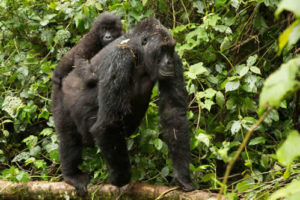 Although the Grauer’s gorilla is not the rarest of the gorilla sub-species (Cross River gorillas and mountain gorillas are), they are the most threatened. There are only 350 Cross River gorillas in Nigeria and Cameroon. Though their numbers are few compared to Grauer’s gorillas, the two governments have done everything within their powers to protect the remaining Cross River gorillas. There are now 1000 mountain gorillas remaining in the world but they are highly protected and given more publicity by tourists who can see them easily. The same cannot be said of the Eastern lowland gorillas in the Democratic Republic of Congo. Their overall population may be higher than both Cross River and Mountain gorillas but they face greater challenges to their existence. Their numbers continue to decrease while that of mountain gorillas continue to rise. The Grauer’s gorilla could became extinct easily if stronger measures are not put in place to contain some of the challenges mentioned earlier.
Although the Grauer’s gorilla is not the rarest of the gorilla sub-species (Cross River gorillas and mountain gorillas are), they are the most threatened. There are only 350 Cross River gorillas in Nigeria and Cameroon. Though their numbers are few compared to Grauer’s gorillas, the two governments have done everything within their powers to protect the remaining Cross River gorillas. There are now 1000 mountain gorillas remaining in the world but they are highly protected and given more publicity by tourists who can see them easily. The same cannot be said of the Eastern lowland gorillas in the Democratic Republic of Congo. Their overall population may be higher than both Cross River and Mountain gorillas but they face greater challenges to their existence. Their numbers continue to decrease while that of mountain gorillas continue to rise. The Grauer’s gorilla could became extinct easily if stronger measures are not put in place to contain some of the challenges mentioned earlier.
